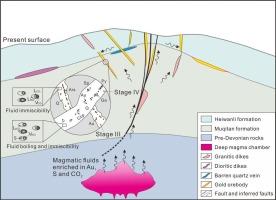Magmatic-hydrothermal fingerprints in lode gold deposits: A case study of the Liushaogou deposit in the West Qinling Orogen, China
IF 3.6
2区 地球科学
Q1 GEOLOGY
引用次数: 0
Abstract
The genesis of gold deposits in the northern belt of the Western Qinling Orogen, hosting numerous world-class gold deposits, remains a contentious issue. The Liushaogou deposit in this region is a quartz vein-style gold deposit, which is strictly controlled by brittle faults, and along with weak silicification and sericitization. Five hydrothermal mineralization stages were identified, including barren quartz (stage I), pyrite-quartz (stage II), quartz-pyrite (stage III), quartz-polymetallic sulfides (stage IV), and quartz-carbonate (stage V). Fluid inclusions within stages I–IV quartz and stage V calcite were studied. Stage I fluids are typified by high temperatures (up to ∼400 °C) and medium to high salinity (8–40 wt% NaCl equiv.), with δ18Ofluid values of 6.21–8.31 ‰, and δD values of −96.1 to −91.6 ‰, aligning with the characteristics of magmatic fluids. Subsequent stages (II-IV) fluids retain magmatic isotopic signatures, while stage V fluids record a shift toward meteoric water (δ18Ofluid: −5.44 to −4.84 ‰; δD: −80.1 ‰ to −74.9 ‰), reflecting late-stage meteoric influx. Physicochemical conditions of the mineralization fluids were estimated to be near-neutral, relatively reduced, and H2S-rich, favoring the transportation of gold as hydrosulfide complexes. Fluid immiscibility and boiling are the primary mechanisms for gold precipitation. Sulfur isotopes (δ34SH2S: 4.9–7.9 ‰) in Liushaogou pyrites closely overlap Triassic magmatic rocks and regional magmatic-hydrothermal deposits, contrasting sharply with heterogeneous δ34S values (−28 ‰ to + 47 ‰) of Paleozoic sedimentary/metamorphic rocks. Homogenous Pb isotopic ratios (206Pb/204Pb: 18.225–18.596; 207Pb/204Pb: 15.623–15.722; 208Pb/204Pb: 38.368–39.115), which are comparable to those observed in Triassic magmatic rocks, further trace metals to Triassic magmas. The evidence presented here, in conjunction with the spatiotemporal links to Triassic intrusions and coeval Au-Mo-Cu mineralization, collectively point to the magmatic-hydrothermal origin of the Liushaogou deposit. This study emphasizes Triassic magmatism as a significant ore-forming process in the northern belt of the Western Qinling Orogen, with implications for targeting concealed intrusions and associated fault systems in regional exploration.

含矿脉金矿床岩浆-热液指纹图谱——以西秦岭造山带柳绍沟金矿为例
西秦岭造山带北段拥有众多世界级金矿,其金矿成因至今仍是一个有争议的问题。本区柳绍沟金矿床为石英脉型金矿床,受脆性断裂严格控制,伴弱硅化、绢云母化。热液成矿分为5个阶段,分别为贫石英阶段(ⅰ阶段)、黄铁矿-石英阶段(ⅱ阶段)、石英-黄铁矿阶段(ⅲ阶段)、石英-多金属硫化物阶段(ⅳ阶段)和石英-碳酸盐阶段(ⅴ阶段)。研究了ⅰ~ⅳ期石英和ⅴ期方解石中的流体包裹体。ⅰ期流体以高温(高达~ 400℃)、中高盐度(8 ~ 40 wt% NaCl当量)为特征,δ 18o值为6.21 ~ 8.31‰,δD值为- 96.1 ~ - 91.6‰,与岩浆流体特征一致。后续阶段(II-IV)流体保持岩浆同位素特征,而V阶段流体向大气水转变(δ 18o流体:−5.44 ~−4.84‰;δD:−80.1‰~−74.9‰),反映了后期的大气流入。成矿流体的物化条件接近中性,相对还原,且富含硫化氢,有利于金以硫化物配合物的形式运移。流体不混溶和沸腾是金沉淀的主要机制。柳少沟黄铁矿的硫同位素(δ34SH2S: 4.9 ~ 7.9‰)与三叠系岩浆岩和区域岩浆热液矿床紧密重叠,与古生代沉积/变质岩的非均质δ34S值(- 28‰~ + 47‰)形成鲜明对比。均质Pb同位素比值(206Pb/204Pb: 18.225 ~ 18.596; 207Pb/204Pb: 15.623 ~ 15.722; 208Pb/204Pb: 38.368 ~ 39.115)与三叠纪岩浆岩中Pb同位素比值相当,进一步证实了三叠纪岩浆岩中微量元素的存在。结合与三叠纪侵入岩的时空联系和同时期的Au-Mo-Cu成矿作用,本文提供的证据共同指向了柳少沟矿床的岩浆-热液成因。本研究强调三叠纪岩浆作用是西秦岭造山带北段重要的成矿作用,为区域找矿指明了隐伏侵入体及伴生断裂体系。
本文章由计算机程序翻译,如有差异,请以英文原文为准。
求助全文
约1分钟内获得全文
求助全文
来源期刊

Ore Geology Reviews
地学-地质学
CiteScore
6.50
自引率
27.30%
发文量
546
审稿时长
22.9 weeks
期刊介绍:
Ore Geology Reviews aims to familiarize all earth scientists with recent advances in a number of interconnected disciplines related to the study of, and search for, ore deposits. The reviews range from brief to longer contributions, but the journal preferentially publishes manuscripts that fill the niche between the commonly shorter journal articles and the comprehensive book coverages, and thus has a special appeal to many authors and readers.
 求助内容:
求助内容: 应助结果提醒方式:
应助结果提醒方式:


